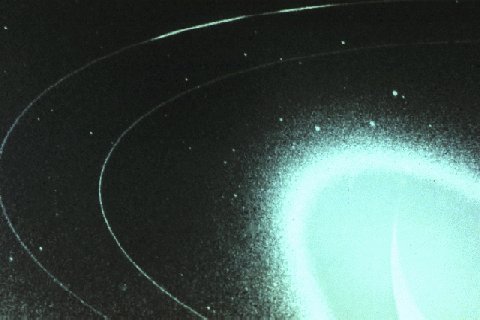

Neptune is the outermost planet
of the gas giants.
It has an equatorial diameter
of 49,500 kilometers (30,760 miles).
If Neptune were hollow, it could contain nearly 60 Earths.
Neptune orbits the Sun every
165 years. It has eight moons, six of which were found by Voyager.
A day on Neptune is 16 hours
and 6.7 minutes.
Neptune was discovered on
September 23, 1846 by Johann Gottfried Galle, and Louis d'Arrest.
Atmosphere Components
The first two thirds of Neptune is composed of a mixture of molten rock, water, liquid ammonia and methane.The outer third is a mixture of heated gases comprised of hydrogen, helium, water and methane.
Methane gives Neptune its blue cloud color.
The largest spot, known as the Great Dark Spot, is about the size of the Earth.
Voyager revealed a small, irregularly shaped, eastward-moving cloud scooting around Neptune every 16 hours or so. This scooter as it has been dubbed could be a plume rising above a deeper cloud deck.
Long bright clouds, similar to cirrus clouds on Earth, were seen high in Neptune's atmosphere.
The strongest winds on any planet were measured on Neptune. Most of the winds there blow westward, opposite to the rotation of the planet. Near the Great Dark Spot, winds blow up to 2,000 kilometers (1,200 miles) an hour.
Magnetic Field
The magnetic field of Neptune,
is highly tilted at 47 degrees from the rotation axis and offset at least
0.55 radii (about 13,500 kilometers or 8,500 miles) from the physical center.
 The
Scooter and the Great Dark Spot.
The
Scooter and the Great Dark Spot.
.
.
Neptune Statistics
Discovered by -----------------------------------------------------------
Johann Gotfried Galle
Date of discovery --------------------------------------------------------
September 23, 1846
Mass (kg) ---------------------------------------------------------------
1.024 x 1026
Mass (Earth = 1) --------------------------------------------------------
17.135
Equatorial radius (km) ----------------------------------------------------
24,746
Equatorial radius (Earth = 1) ----------------------------------------------
3.8799
Mean density (gm/cm3) ---------------------------------------------------
1.64
Mean distance from the Sun (km) -----------------------------------------
4,504,300,000
Mean distance from the Sun (Earth = 1) -----------------------------------
30.0611
Rotational period (hours) --------------------------------------------------
16.11
Orbital period (years) -----------------------------------------------------
164.79
Mean orbital velocity (km/sec) ---------------------------------------------
5.45
Orbital eccentricity ---------------------------------------------------------
0.0097
Tilt of axis (degrees) --------------------------------------------------------
28.31
Orbital inclination (degrees) -------------------------------------------------
1.774
Equatorial surface gravity (m/sec2)
------------------------------------------- 11.0
Equatorial escape velocity (km/sec) ------------------------------------------
23.50
Visual geometric albedo -----------------------------------------------------
0.41
Magnitude (Vo) -------------------------------------------------------------
7.84
Mean cloud temperature -----------------------------------------------------
-193 to -153°C
Atmospheric pressure (bars) -------------------------------------------------
1-3
Atmospheric composition ------------------------------
Hydrogen85%, Helium 13%, Methane 2%
.
.
 Rings
of Neptune.
Rings
of Neptune.
.
Rings
Neptune has a set of four rings
which are narrow and very faint.
.
.
 Neptune's Moon, Triton.
Neptune's Moon, Triton.
.
.
The following table summarizes the radius, mass,
distance from the planet center, discoverer and the date of discovery of
each of the moons of Neptune:
|
|
|
|
|
|
|
|
|
|
|
|
|
|
|
|
|
|
|
|
|
|
|
|
|
|
|
|
|
|
|
|
|
|
|
|
|
|
|
|
|
|
|
|
|
|
|
|
|
|
|
|
|
|
|
|
|
|
|
|
|
|
|
|
|
|
|
|
|
|
|
|